“Doomsday Clock #10” described the ever changing DC Universe as a “metaverse” based around Superman. It uses a frequent writer fascination with retelling this well known story combined with a new explanation of the evolving hero. No longer were different origins on different Earths or wiped out by time traveling, universe ending crises! It’s all one universe that the rest of the multiverse reacts to impacted by outside forces. Of course, with Big Blue at the center. With Frank Miller and John Romita Jr’s “Year One” promising to tell a “definitive” version of our hero’s origin, let’s take a look back at how it’s changed and been retold over the 80+ years of his existence.
In the beginning
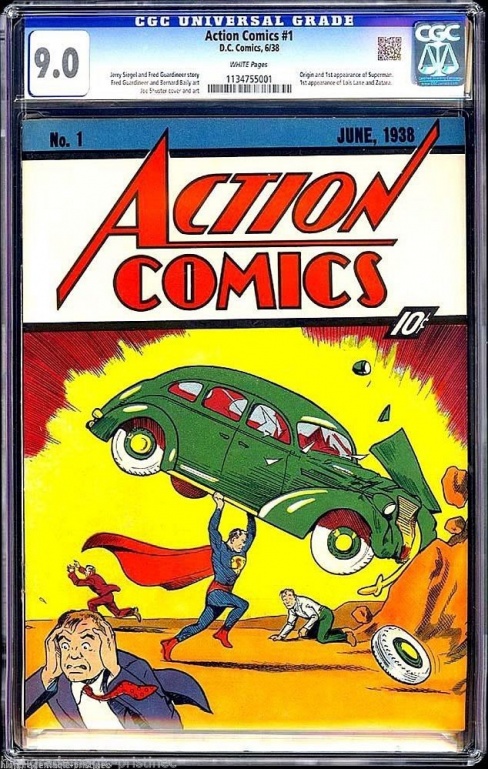
When Superman first debuted in “Action Comics #1”, one page was dedicated to his origin. Distant planet destroyed by old age, hastily devised space-ship, raised in an orphanage, named Clark, amazing abilities, and a little “scientific explanation.” They needed something to set the scene, but Superman was created for newspaper strips — Siegel and Shuster needed to get right to the action. This single page origin was done again brilliantly by Frank Quitely and Grant Morrison for “All Star Superman.” April 18, 1938 is widely regarded as the “Action Comics’ #1 release date these days, and was used as the date Superman smashed the green sedan in “Doomsday Clock,” despite probably not being the actual on sale date. It’s hard to narrow down when a comic book hit newsstands 81 years ago.
This origin has the core idea and very little of it has changed since. A year later in the first issue of his eponymous title, two whole pages were given to explore the Man of Tomorrow’s beginnings. We got Krypton, the Kent’s (Mary not Martha), and their adoption. The first story here is a retelling of “Action Comics” #1, repeating the classic car smash that is often imitated, but never duplicated.
It took until his 10th anniversary for us to get a real dedicated origin. “Superman #53” was a 10th anniversary issue featuring ‘The Origin of Superman.’ We meet Jor-El (later retconned to Jor-L keeping with Superman’s Golden Age name of Kal-L) along with John and Mary Kent again. The story asks “Who is Superman? Where did he come from? How did he obtain his miraculous powers?” In this telling it’s John Kent, on his deathbed, that gives Clark the name Superman. “They must never know that Clark Kent is a… Super-Man! Remember, because that’s what you are… a Superman!”
The rest is pretty familiar — Jor-El declares Krypton is doomed, no one believes him, little Kal-El leaves in a rocket. As he ages he discovers his incredible powers. Curiously this story ignores the adventures of Superman when he was a boy. Superboy debuted 3 years earlier in ‘The Origin of Superboy’ from “More Fun Comics” #101. How did they reconcile this? A retcon of course. “More Fun Comics” #101 became the first appearance of Earth 1. The Golden Age Superman of this story was from Earth 2 and had no career as Superboy.
Three years later we get almost the same origin story. Subtle differences include Jor-El’s new costume (Red with a lightning bolt instead of Green with a Saturn like planet) and Jonathan Kent’s dying words “Your super-powers made you a champion of right as Superboy! Now you must continue your role as Superman– but always keep your true identity hidden!” Finally, an acknowledgement of Superboy. This retelling seems more like filler than an attempt to really tell a definitive origin. It’s mostly the same as the previous telling and it’s sandwiched in the middle of a story about a Kryptonite meteorite falling towards the city of Smithville. Don’t worry Superman uses a little ingenuity (and some robots) to save the day.
Weisinger’s Hard Sci-Fi Silver Age
“Superman” #141’s ‘Superman’s Return to Krypton!’ has the Man of Tomorrow visiting Krypton in the past. Complete with an LL love interest: Lyla Lerrol. This Jerry Siegel & Wayne Boring tale give a pretty definitive origin of his time on Krypton. For at least six months…
Told for the first time–the cover exclaims–the complete story of Superman’s life! “Superman 146” from 1961 has it all. Artist Al Plastino and writer Otto Binder give us the definitive version of Pre-Crisis Superman’s origin. It’s got all the hits: Jor-El in his green suit with a sun and yellow head band, Jonathan and Martha Kent, Superboy, Lana Lang, Krypto, Jonathan’s last words, Metropolis University, and finally the Daily Planet. It even gives us the red sun/yellow sun explanation of his abilities. His suit comes from the unraveled indestructible baby blankets. He’s got a Superboy robot to fool Lana. Supes even gets honorary citizenship in all countries of the UN, but remains loyal to the United States. It’s either this or 141 that is the Silver Age version mentioned in “Doomsday Clock.” The time frame they give is 1956 which was the first appearance of Barry Allen as The Flash and the beginning of DC’s Silver Age.
Continued below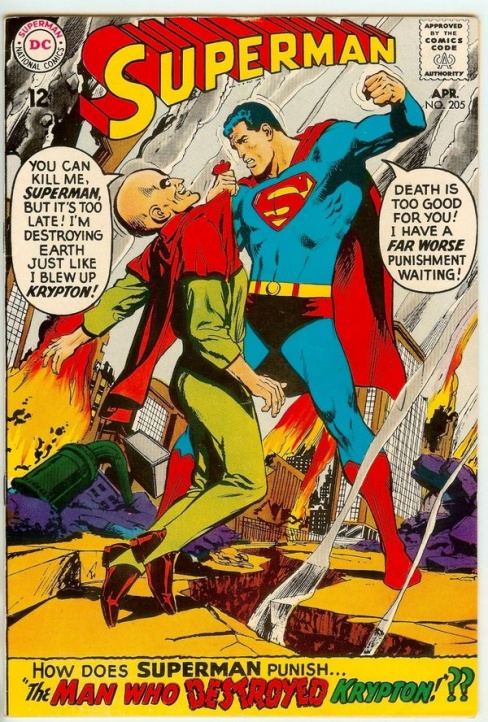
Before the 60s would come to an end, we’d get an interesting retcon to the origin and the introduction of Black Zero. “Superman” #205: ‘The Man Who Destroyed Krypton!’ Super-villain Black Zero is actually responsible for the destruction of the planet and Jor-El was wrong! Krypton must be destroyed because they are about to become a space-faring race. He eventually meets his fate when he comes face to face with Phantom Zone villain Jax-Ur. Any of this sound familiar, Bendis? The name Black Zero shows up again both Post-Crisis and in the current Syfy Television series Krypton, but neither retelling bare much similarity to the bald villain we get here.
The Bronze Age

DC couldn’t let another decade come and go without a retelling. In 1979’s “Action Comics #500” we get a very similar Pre-Crisis origin. Some fun new details include Pa Kent designing the “S,” his boots being made from the rocket’s upholstery, and his belt from the rocket’s seat belt. Martin Pasko does a serviceable job with the script and an interesting framing device of Superman using a found Kryptonian device to actually remember his time as a baby. The real draw of this issue and what makes it worth tracking down is the art by one of the definitive Superman artists, Curt Swan.
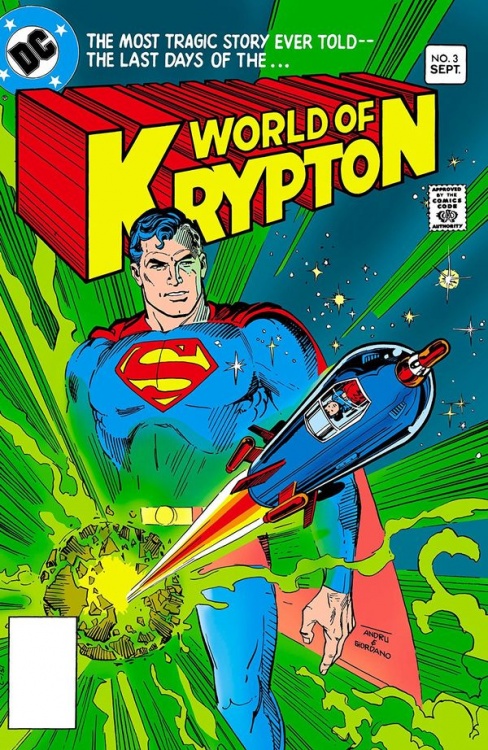
The Bronze Age also included back-up stories detailing Krypton’s history and what’s widely regarded as the first miniseries, “World of Krypton.” These stories flesh out the sci-fi world of Krypton deeper than ever; Krypton gets a calendar (destroyed on 39 Ogtal 10,000) and a deep history dating back to the very beginnings of their civilization. Back then, Superman had always found ways to return to Krypton. He was present for his parent’s wedding and Brainiac’s bottling of Kandor. The Bronze Age also gets the ‘Secret Years’ detailing Clark’s time in college and includes some great Frank Miller covers from before he would make Superman a stooge for the Regan establishment.
Post-Crisis Man of Steel

October 1986: Manhattan arrives in Smallville to see Clark discover the birthing matrix ship from John Byrne’s “Man of Steel” miniseries. Two years before Superman’s 50th anniversary, DC decided it was time to clean house. Using “Crisis on Infinite Earths” to wipe the slate, and Superman gets an update for the 80s. Sure, the basics from “Action Comics” #1 haven’t changed, but the details are all new. This new Krypton doesn’t have headbands and jewel mountains. It’s a cold, unfeeling, dystopia where Kryptonians are grown in pods and don’t come in contact with one another. This new origin introduces Superman’s grandfather as Seyg-El in tribute to Jerry Siegel his co-creator. He would later become known as Seg-El for television’s Krypton. Byrne further expanded on his Krypton in a new “World of Krypton” miniseries, reintroducing Black Zero as a terrorist organization after a clone war whose bomb experiments lead to the eventual destruction of the planet generations later.
No longer was Superman fighting the never-ending battle as Superboy, as his powers manifested throughout his youth, something explored in detail on the television show Smallville. Byrne also kept Clark’s adopted parents alive; having Jonathan and Martha Kent around through adulthood gave him a connection in his adulthood that he lacked in the Silver Age. He didn’t need another tragic death to inspire him to be Superman. He already lost his entire world! Byrne’s Krypton is often said to be inspired by the Christopher Reeve movies, but it seems to me wholly original. The biggest borrow was Lois naming Superman after he saves her on an experimental space plane, echoing the helicopter rescue in Superman: The Movie and then referenced in Superman Returns.

This origin heavily influenced the Krypton and the plot of 2013’s Man of Steel. Kryptonians aren’t born they are grown. The Krypton sequence of that film remains its most original and interesting idea, leading to the film’s screenwriter, David Goyer, producing Krypton for Syfy.
Byrne’s Superman did away with all the other Kryptonian survivors that had amassed over the years. Kal-El was truly the Last Son of Krypton again. The look of Krypton, its technology, and even fashion were all completely new. This starts a run of some of the tightest continuity in Superman stories in history. Lasting around 17 years before the publication of “Superman: Birthright.” Even “Zero Hour,” which restarted all of time in the DC Universe, didn’t change much. He just got a new childhood friend turned villain in Conduit. Through this time, small ideas presented in one off issues would come back as greater threats years down the line rewarding long time readers. They also kill Superman off at one point, but that’s a story for another day.
Continued below2001’s ‘Return to Krypton,’ referencing the classic story title, seemed to indicate that the Pre-Crisis version was the real Krypton. We even got that great green Jor-El suit! This all turned out to be a Brainiac trick, but it did give us Krypto in modern continuity again.
Birthright, Infinite Crisis, and Secret Origin
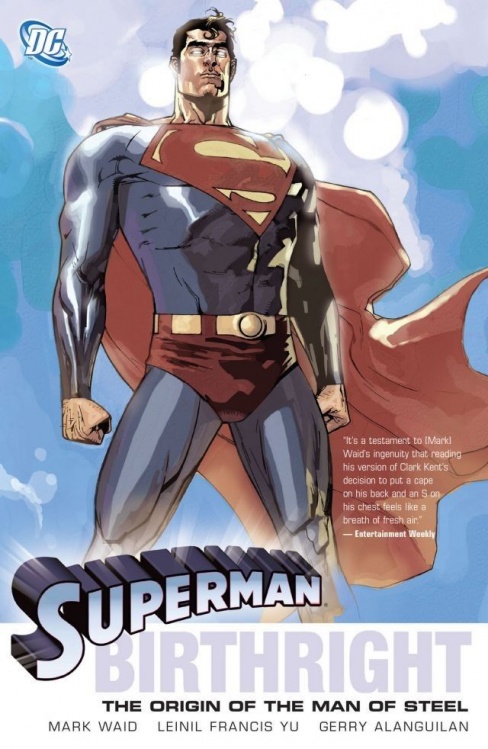
When Mark Waid and Lenil Francis Yu started “Superman: Birthright,” readers expected it to be an out of continuity story. It eventually got canonized and was the definitive version for a short while. “Birthright” introduced some elements that are familiar to current movie goers while also borrowing elements from the big screen. The “S” is no longer something the Kents came up with. It’s a Kryptonian symbol. Just like Marlon Brando’s Jor-El wears in Superman The Movie. But this time it’s more than just the family symbol. It stands for hope.
Even after “Birthright” wiped out most of Byrne’s changes with a more Silver Age inspired Krypton, some Byrne style creeped in over the years. In Geoff John’s ‘New Krypton’ saga, we see Kryptonians in clothing inspired by the many retellings over the years.
“Birthright” held up until “Infinite Crisis” messed with things again, but despite this we didn’t get another origin retelling for years. The ‘One Year Later’ “Up, Up, and Away!” story gives us another Superman: The Movie reference with the “sunstone” crystal. Different Superman media is always influencing each other with the best ideas often bubbling to the surface. We then get the full “Secret Origin” treatment in 2009. Geoff Johns tries to make everyone happy with his take by mixing and matching elements from older versions. Like in the old Superboy stories, young Lex is in Smallville with Clark. But like Byrne, there was no Superboy. Jor-El’s clothes even resemble the robes Brando wore. Gary Frank’s Superman was the closest likeness to Christopher Reeve the comics had ever seen and remains a fan favorite.
Manhattan witness the “Birthright” ship and the “Secret Origin” ship arrive in quick succession which inspires him to create the New 52.
New 52

In 2011, lagging sales and the “Flashpoint” series gave DC the opportunity to do a line-wide relaunch. Brought in to retell Superman’s origin once again was “All Star Superman”‘s Grant Morrison. Externally, it looked like sweeping changes were made, but on closer inspection Morrison’s early Superman was heavily inspired by Siegel and Shuster’s “champion of the oppressed” and the early deaths of the Kents that had been a part of the Superman story for years. The New 52 costume introduced in Justice League #1 by Jim Lee and Geoff Johns definitely seemed like an attempt to make Superman appear “cool;” he’s got armor and doesn’t wear his trunks on the outside. He’s younger and hip. Despite strong initial sales, this Superman didn’t seem to resonate with long time fans. Even the renumbered titles didn’t last; once they hit “Action Comics” #52 they went back to the legacy numbering.
Morrison’s New 52 origin coming in “Action Comics” #5 borrows a bit from Superman: The Animated Series, connecting Brainiac more closely to Krypton. This Krypton had the headbands, but also the S stays as a symbol of the House of El. The suit isn’t inspired by circus strongmen from the 30s; it’s Kryptonian armor that adapted to what he needed. This idea carried into the Man of Steel movie as well.
Rebirth and Beyond!
2015’s “Convergence” introduced the idea that before the destruction of all of these previous universes or timelines bits and pieces were saved by a Brainiac inspired Collector. I’m not sure how this lines up with Doctor Manhattan’s metaverse hypothesis, since this series is basically an excuse to show old versions of characters and have them fight. The major lasting impact of this series for Superman comes with the birth of Jonathan Samuel Kent to the Pre-Flashpoint Superman and Lois. At the end of this series the DC Universe has two Supermen! When New 52 Superman dies he is quickly replaced with the Superman some of the older audience was more familiar with. Then comes ‘Rebirth.’ For about a year this old Superman slowly moves himself into the new Superman’s life. But this wasn’t meant to last.
Continued below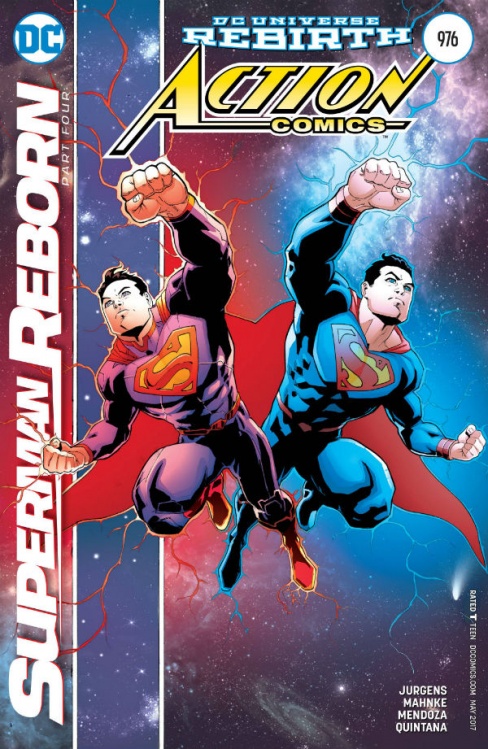
Just over a year later we get ‘Superman: Reborn.’ Due to Doctor Manhattan’s meddling, Mxyzptlk has been imprisoned and Jor-El is still alive, plucked from Krypton moments before its destruction. Superman’s sheer force of will in a battle with Mxy merges the two realities. Now there was never a New 52 Superman and his new history and origin is yet another amalgamation.
All of this brings us to today. Superman’s merging of the realities in Reborn backs up Manhattan’s metaverse hypothesis. Jor-El being alive plays heavily into Brian Michael Bendis’s ‘Unity Saga,’ which also utilizes Jon Kent. Bendis didn’t do a reboot and new origin in his “Man of Steel” miniseries as some readers may have expected. Will we get another retelling at the end of “Doomsday Clock?” There is still some confusion on whether Ma and Pa Kent are currently alive in this continuity. Will “Year One” be the in continuity origin or because it’s Black Label will it be a stand alone like the great “For All Seasons” and “All Star?” So far, the biggest changes from “Year One” are Pa Kent finds baby Kal-El without Martha and young Clark joins the military. No telling where Miller and Romita will go from here. This of course leaves out the many either out of continuity stories or alternate “Elseworlds” tales of Superman.
It seems there are a few points that writers won’t change and are too core and central to the character, like being rocketed from a doomed world and using his amazing abilities to fight for good (or Truth, Justice, and the American Way). But there also seem to be pieces that can fluctuate depending on the times. These seem to be less integral to the character and the stories being told with him, like the status of the Kents or the minute details of life on Krypton (did you know Kryptonian council members Pre-Crisis were called Moliom). The Silver Age ramped up the sci-fi detail, whereas Byrne brought a bit of 80s modern malaise. What will the millennial Superman be like? What will writers change in the next 80 years?



